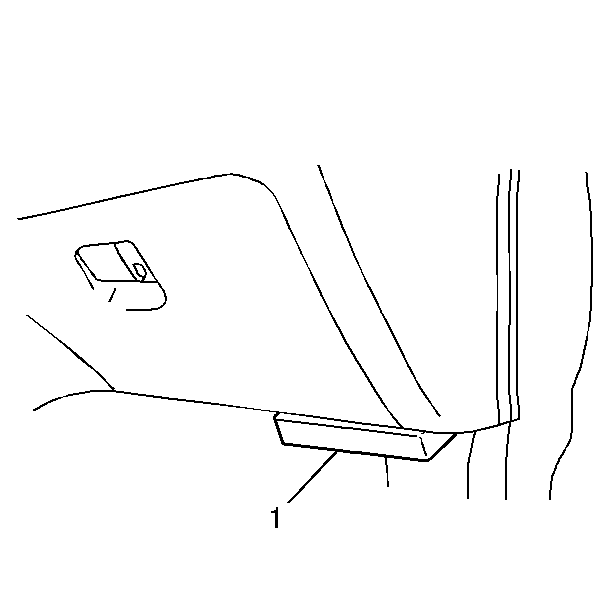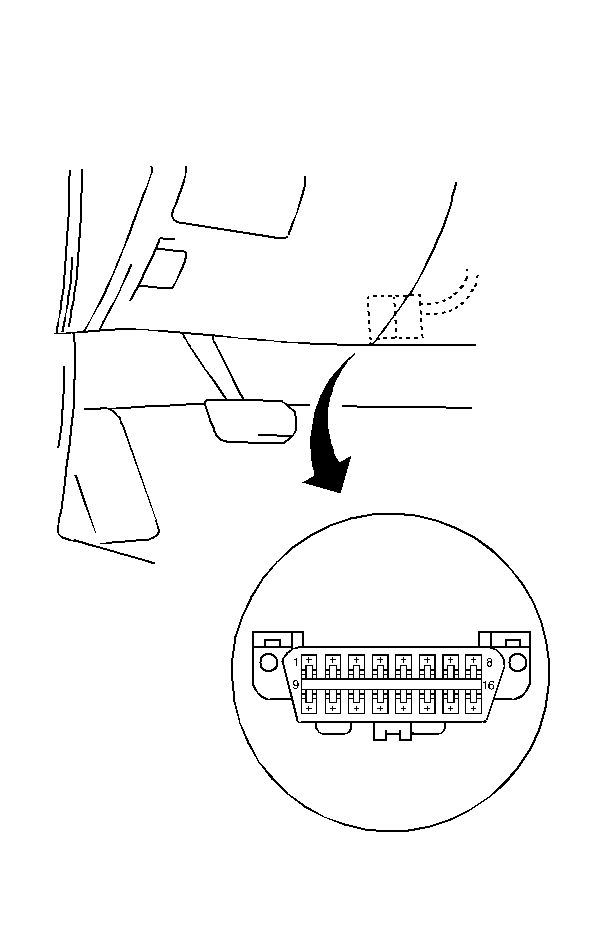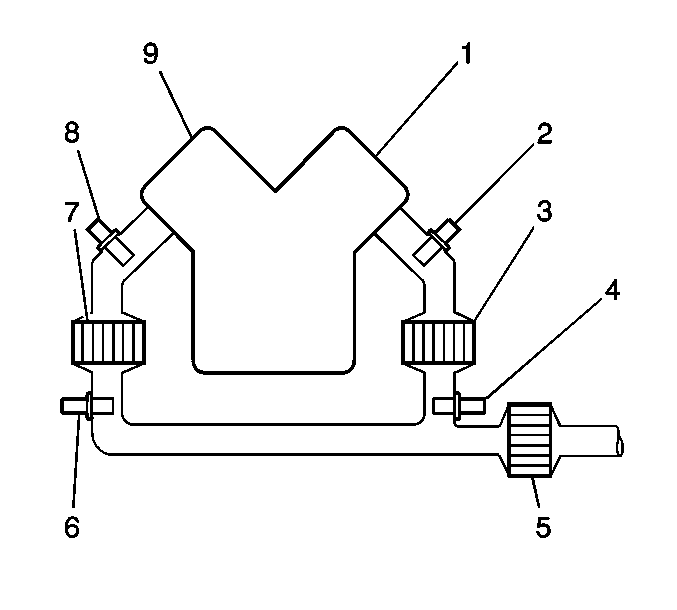
The powertrain control
module (PCM) is a precision unit consisting of a one chip microprocessor,
an analog/digital (A/D) converter, and an input/output
(I/O) unit. The PCM is an essential part of the electronic
control system. The PCM is responsible for such major
functions as control of the fuel injectors, the idle air
control (IAC) valve, the fuel pump relay, etc. The PCM performs
the OBD 2 diagnostic tests of the emission related
systems. The PCM supplies a buffered voltage to the various
information sensors and switches. The PCM controls most
components with an electronic switch that completes a ground
circuit when turned on. The PCM is also responsible for
a self-diagnosis function and a fail-safe function.
The PCM (1) is located below the glove box, underneath the instrument
panel, on the right side of the passenger compartment.
PCM EPROM
The PCM has an erasable programmable read-only memory (EPROM) computer
chip that contains the calibration information used by the PCM to control
fueling, idle speed, ignition timing, transaxle shifts, and
vehicle emissions. The calibration information is based on
various aspects of the vehicle, such as engine size, vehicle
weight, transaxle type, final drive ratio, etc. The EPROM is
programmed (flashed) with the calibration information that is
critical to the proper operation of the PCM. The EPROM is soldered
into the PCM and cannot be serviced separately. Replacement
PCMs used for service require programming after installation.
Self-Diagnosis Function
The PCM diagnoses any troubles which may occur in the engine control
system when the ignition switch is in the ON position with
the engine running. The PCM indicates a malfunction by illuminating
the malfunction indicator lamp (MIL) when a fault occurs
in any of the following systems:
| • | The fuel control heated oxygen sensors (HO2S) |
| • | The catalyst monitoring heated oxygen sensors |
| • | The engine coolant temperature (ECT) sensor |
| • | The throttle position (TP) sensor |
| • | The mass air flow (MAF) sensor |
| • | The vehicle speed sensor (VSS) |
| • | The intake air temperature (IAT) sensor |
| • | The manifold absolute pressure (MAP) sensor |
| • | The camshaft position (CMP) sensor |
| • | The crankshaft position (CKP) sensor |
| • | The evaporative emission (EVAP) control system |
| • | The idle air control (IAC) system |
| • | The cooling fan control |
| • | The central processing unit (CPU) of the PCM |
When the PCM detects a malfunction in one of the above areas, the PCM
will illuminate or flash the MIL in order to notify the driver of the occurrence
of a fault. The PCM will store a diagnostic trouble
code (DTC) when the PCM illuminates the MIL.
The PCM will turn OFF the MIL after 3 consecutive ignition cycles, in
which the diagnostic runs, without the malfunction occurring. The DTC will
remain stored in the PCM memory after the MIL is
OFF.
Fail-Safe Function
When a malfunction occurs within the engine control system, the PCM
maintains control over the fuel injection system, the
idle speed control system, etc. The PCM controls these systems
by using calculated values and backup programs stored
within the PCM.
This function is called the fail-safe function. With the fail-safe function,
a certain level of engine performance is available even when a malfunction
occurs. The fail-safe function prevents a
complete loss of engine performance.
The systems covered by the fail-safe function are as follows:
| • | The engine coolant temperature (ECT) sensor |
| • | The throttle position (TP) sensor |
| • | The mass air flow (MAF) sensor |
| • | The intake air temperature (IAT) sensor |
| • | The vehicle speed sensor (VSS) |
| • | The barometric (BARO) pressure sensor |
| • | The central processing unit (CPU) in the PCM |
Control Module Learning Ability
The control module has a "learning" ability which enables
the control module to make corrections for minor variations in the fuel system.
This learning ability can improve driveability.
Disconnecting the battery resets the learning
process. A change in the vehicle's performance may
be noticed when a reset occurs. The vehicle operator
can teach the control module in order to regain
some of the lost vehicle performance.
In order to teach the control module, ensure that the engine is at operating
temperature and drive the vehicle at part throttle with moderate acceleration.
The vehicle may also be operated at idle
conditions until normal performance returns.
PCM Output Controls
Important: Do not use the scan tool's Output Control feature until the vehicle
is at normal operating temperatures. The PCM will not respond to a scan tool
request for Output Controls until the engine coolant temperature
is above 80°C (175°F). Failure to wait for normal operating
temperatures can result in the incorrect diagnosis of a driveability
problem.
Output Controls are disabled when any DTCs are stored by the PCM. Clear
all DTCs before using Output Controls on the scan tool.
The powertrain control module (PCM) can be directed by the Tech 2
scan tool to operate certain solenoids, valves, motors, and switches. This
scan tool function is generally referred to as Output Controls.
Output controls can be found under Special Functions on the Tech 2
scan tool. Operating a PCM controlled device with the scan tool
should be limited to a maximum of ten seconds per test period.
Data Link Connector (DLC)

Important: Do not use a scan tool that displays faulty data. Report the scan tool
problem to the manufacturer. Use of a faulty scan tool can result in misdiagnosis
and unnecessary parts replacement.
The provision for communicating with the control module is the data
link connector (DLC). The DLC is located under the instrument panel to
the right of the steering column. The DLC is used to connect to
a scan tool. Some common uses of the scan tool are listed below:
| • | Identifying stored diagnostic trouble codes (DTCs). |
| • | Performing output control tests. |
| • | Reading the serial data. |
Reading Diagnostic Trouble Codes Using a Scan Tool
The procedure for reading diagnostic trouble codes is to use a diagnostic
scan tool. Follow the instructions supplied by the scan tool manufacturer
in order to read DTCs accurately.
Clearing Diagnostic Trouble Codes
Important: Do not clear the DTCs unless directed to do so by the service information
provided for each diagnostic procedure. The Freeze Frame data which may help
diagnose an intermittent fault will be erased from the memory when
the DTCs are cleared.
The PCM will begin to count the warm-up cycles when the fault that caused
the DTC to be stored into memory has been corrected. The DTC will automatically
be cleared from the PCM memory when the PCM has counted forty (40)
consecutive warm-up cycles with no further faults detected.
Diagnostic trouble codes (DTCs) can be cleared using a scan tool. In
order to clear DTCs, use the scan tool's clear the DTCs or clear the information
function. Follow the instructions supplied by the scan tool manufacturer.
PCM Service Precautions
Notice: Turn the ignition OFF when installing or removing the PCM connectors
and disconnecting or reconnecting the power to the PCM (battery cable, PCM
pigtail, PCM fuse, jumper cables, etc.) in order to prevent internal PCM damage.
Important: Before replacing the powertrain control module (PCM) make sure that
the PCM contains the correct calibrations for the model, equipment, and year
of the vehicle being serviced. A PCM incorrectly programmed, or
with the wrong calibrations, can set false or incorrect DTCs. Incorrect
calibrations can also cause driveability symptoms and concerns.
The powertrain control module (PCM) is designed to withstand normal
current draws associated with vehicle operations. Avoid overloading any circuit.
Do not ground or apply voltage to any of the PCM circuits unless
instructed to do so. Do not apply voltage to any of the PCM circuits
when testing for an open or a short in an electrical circuit. The
PCM circuits should only be tested using the J 39200
digital multimeter (DMM) or an equivalent.
The PCM electrical connectors should remain connected to the PCM
during testing.
Aftermarket (Add-On) Electrical And Vacuum Equipment
Notice: Connect any add-on electrically operated equipment to the vehicle's
electrical system at the battery (power and ground) in order to prevent damage
to the vehicle.
Notice: Do not attach add-on vacuum operated equipment to this vehicle. The
use of add-on vacuum equipment may result in damage to vehicle components
or systems.
Aftermarket (add-on) electrical and vacuum equipment is
defined as any equipment installed on a vehicle after leaving the factory
that connects to the vehicle's electrical or vacuum systems.
No allowances have been made in the vehicle design for addition
of this type of equipment.
Add-on electrical equipment may cause the engine control system to malfunction
even when the add-on electrical equipment is installed properly. Portable
telephones and radios may also cause engine control system malfunctions
even when not connected to the vehicle's electrical system. The
first step in diagnosing any engine control system problem is to
remove all aftermarket electrical equipment from the vehicle. Diagnosis
may proceed in the normal manner after eliminating aftermarket
equipment as a cause of the engine control system malfunction.
Electrostatic Discharge (ESD) Damage
Notice: In order to prevent possible Electrostatic Discharge damage to the PCM,
Do Not touch the connector pins or the soldered components on the circuit
board.
Electronic components used in the engine control system
are often designed to operate at very low voltages. Electronic components
are susceptible to damage caused by electrostatic discharge. Less
than 100 volts of static electricity can cause damage to
some of the electronic components. There are several ways for a
person to become statically charged. The most common methods of
charging are by friction and by induction. An example of charging
by friction is a person sliding across a car seat. Charging by induction
occurs when a person with well insulated shoes stands near a highly
charged object and momentarily touches ground. Charges of the same
polarity are drained off leaving the person highly charged with
the opposite polarity. Therefore, it is important to use care when
handling and testing electronic components in order to avoid electrostatic
charges that can cause electronic component damage.
Input Components
The PCM supplies a buffered voltage to the various information sensors
and switches. The PCM monitors the input components
for circuit continuity and out-of-range values. The PCM
also provides performance checking. Performance
checking refers to the PCM indicating a fault
when the signal from an input does not seem reasonable
(i.e. a throttle position (TP) sensor that
indicates a high throttle position at low engine loads
or low manifold absolute pressure sensor voltage).
The input components may include, but are not
limited to the following sensors and switches:
| • | The vehicle speed sensor (VSS) |
| • | The crankshaft position (CKP) sensor |
| • | The throttle position (TP) sensor |
| • | The engine coolant temperature (ECT) sensor |
| • | The camshaft position (CMP) sensor |
| • | The mass air flow (MAF) sensor |
| • | The manifold absolute pressure (MAP) sensor |
| • | The heated oxygen sensors (HO2S) |
| • | The fuel tank pressure (FTP) sensor |
| • | The transmission range (TR) switch |
| • | The power steering pressure (PSP) switch, if equipped |
Output Components
The PCM is responsible for the control and operation of many output
components. The PCM controls many components with
an electronic switch that completes a ground circuit when
turned ON. The PCM monitors the output components
for the proper response to the PCM commands.
Components where functional monitoring is not feasible
will be monitored for circuit continuity and out-of-range
values if applicable.
Output components to be monitored include, but are not limited to, the
following circuits:
| • | The idle air control (IAC) valve |
| • | The exhaust gas recirculation (EGR) valve |
| • | The malfunction indicator lamp (MIL) control |
| • | The A/C compressor control module, or the A/C relay |
| • | The A/C condenser cooling fan relay |
Catalyst Monitor Diagnostic Operation




